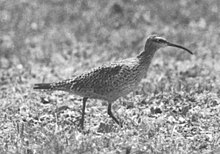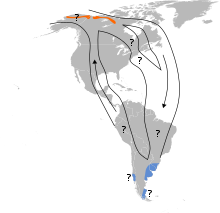| Eskimo curlew | |
|---|---|

| |
| One of four known photographs of a living Eskimo curlew, taken by Don Bleitz on Galveston Island in 1962 | |
| Scientific classification | |
| Domain: | Eukaryota |
| Kingdom: | Animalia |
| Phylum: | Chordata |
| Class: | Aves |
| Order: | Charadriiformes |
| Family: | Scolopacidae |
| Genus: | Numenius |
| Species: | N. borealis
|
| Binomial name | |
| Numenius borealis (Forster, 1772)
| |

| |
The Eskimo curlew (Numenius borealis), also known as northern curlew, is a species of curlew in the family Scolopacidae. It was one of the most numerous shorebirds in the tundra of western Arctic Canada and Alaska. Thousands of birds were then killed per year in the late 1800s. As there has not been a reliable sighting since 1987 or a confirmed sighting since 1963, the Eskimo curlew is considered Critically Endangered or possibly extinct.[3] The bird is about 30 cm (12 in) long and fed mostly on insects and berries.

- ^ BirdLife International (2021). "Numenius borealis". IUCN Red List of Threatened Species. 2021: e.T22693170A178901365. doi:10.2305/IUCN.UK.2021-3.RLTS.T22693170A178901365.en. Retrieved 12 November 2021.
- ^ "Appendices | CITES". cites.org. Retrieved 2022-01-14.
- ^ "Numenius borealis. NatureServe Explorer 2.0".
